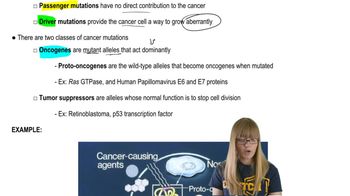Table of contents
- 1. Introduction to Genetics51m
- 2. Mendel's Laws of Inheritance3h 37m
- 3. Extensions to Mendelian Inheritance2h 41m
- 4. Genetic Mapping and Linkage2h 28m
- 5. Genetics of Bacteria and Viruses1h 21m
- 6. Chromosomal Variation1h 48m
- 7. DNA and Chromosome Structure56m
- 8. DNA Replication1h 10m
- 9. Mitosis and Meiosis1h 34m
- 10. Transcription1h 0m
- 11. Translation58m
- 12. Gene Regulation in Prokaryotes1h 19m
- 13. Gene Regulation in Eukaryotes44m
- 14. Genetic Control of Development44m
- 15. Genomes and Genomics1h 50m
- 16. Transposable Elements47m
- 17. Mutation, Repair, and Recombination1h 6m
- 18. Molecular Genetic Tools19m
- 19. Cancer Genetics29m
- 20. Quantitative Genetics1h 26m
- 21. Population Genetics50m
- 22. Evolutionary Genetics29m
19. Cancer Genetics
Cancer Mutations
Problem 9d
Textbook Question
Textbook QuestionGo to the website http://www.cancer.gov and select 'Cancer Types' on the top menu bar. Scroll down to 'Breast Cancer' and click. Select 'Cases & Prevention' from the options. Click 'More information' and select 'BRCA Mutations: Cancer Risk and Genetic Testing'. Use the information on this page to answer the following questions. What are the approximate percentage increases in risk of having breast cancer and of having ovarian cancer for women inheriting harmful mutations of BRCA1 and BRCA2 compared with the risks in the general population?
 Verified Solution
Verified SolutionThis video solution was recommended by our tutors as helpful for the problem above
Video duration:
2mPlay a video:
Was this helpful?
Key Concepts
Here are the essential concepts you must grasp in order to answer the question correctly.
BRCA1 and BRCA2 Genes
BRCA1 and BRCA2 are genes that produce proteins responsible for repairing damaged DNA. Mutations in these genes can impair their function, leading to an increased risk of developing certain cancers, particularly breast and ovarian cancer. Women with harmful mutations in these genes have a significantly higher lifetime risk of these cancers compared to the general population.
Recommended video:
Guided course

Mapping Genes
Cancer Risk Assessment
Cancer risk assessment involves evaluating an individual's likelihood of developing cancer based on genetic, environmental, and lifestyle factors. For BRCA mutations, this assessment includes understanding the statistical increase in risk for breast and ovarian cancers, which is often expressed as a percentage compared to the baseline risk in the general population.
Recommended video:
Guided course

Cancer Characteristics
Genetic Testing
Genetic testing for BRCA mutations involves analyzing an individual's DNA to identify harmful changes in the BRCA1 and BRCA2 genes. This testing can provide critical information about cancer risk, guiding preventive measures and treatment options. Understanding the implications of test results is essential for making informed health decisions.
Recommended video:
Guided course

History of Genetics

 4:50m
4:50mWatch next
Master Cancer Mutations with a bite sized video explanation from Kylia Goodner
Start learningRelated Videos
Related Practice


